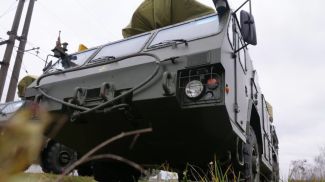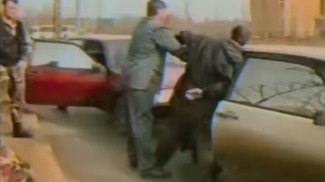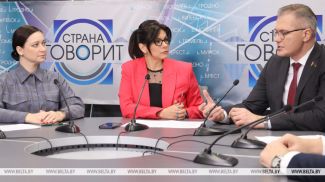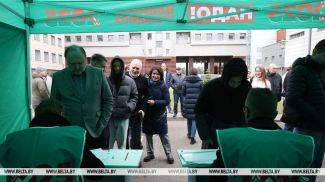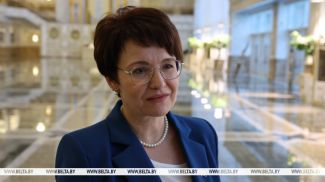Lengthy and intensive fighting has changed Mariupol beyond recognition. The city is in a deplorable state and its restoration will require considerable time and effort. A BelTA reporter went to the city and saw how the population center is getting on after heavy shelling and firefights.
Mariupol welcomes its rare guests with concrete letters that form the city's name. They were painted in colors of the Russian flag in anticipation of Russia Day. It looks impressive without exaggeration. A truck with Russian military personnel flies by. The guys shout “No pasaran!” to us – the famous slogan of the anti-fascist movement from the days of the Spanish Civil War. I smile and raise a fist in approval. The truck drives out of sight.
We drive into the city. Not a single building has been left untouched after all the firefights in Mariupol. Windows are broken, houses are blackened by fire, trees are in splinters. A depressing sight. The number of people in streets of the city is surprising. Getting back to normal life is probably not an easy thing to do after all they've been through. I wouldn't want it upon anyone. But these people live on. They are rebuilding the city from the ruins and are restoring the destroyed infrastructure.
Mariupol's port is operational and is ready to send and receive cargoes. It looks impressive. The tall cranes prop the skies, various vessels are moored at the wharves, and the port's territory stretches for a long distance. It is too early for the port to resume normal operation but workers are already toiling on the shore and ships cruise in the sea. The port was also damaged in the course of the battle for Mariupol: most of the buildings were destroyed but thankfully the cranes and machines got off lightly.
Some sections of the shoreline are still riddled with mines. Army engineers are still working on clearing them. The Black Sea Fleet is taking care of that. Two vehicles are employed: one on the ground and one in the water with a trawl between them. The vehicles move along the shoreline and detonate the mines hit by the trawl. One can say it is a unique technology. When a mine explodes, we get sprayed with cool seawater due to the water plume. The vehicles move on and more and more water plumes appear behind them. The sight is captivating. But you'd better watch it from under a canopy to avoid shrapnel that goes with the water plumes. We are told it is not a good idea to take the pieces as souvenirs: they say it is bad luck.
We get on a bus and move on. The Mariupol philharmonic is the next stop. Locals could use some recreation after all the hard work. There is no orchestra and no musicians in the philharmonic. Actors of a local theater, which has been destroyed by an explosion, are on stage. They are rehearsing a play and are doing their best: they gesticulate, exclaim, correct each other, and suggest how best to perform the episode. Their feelings are genuine. Locals need them as much as they need medics or construction workers. Shelling, bombardment, and explosions in Mariupol are a thing of the past now and represent one of the most tragic episodes in the city's history. A peaceful life awaits local residents and culture plays a decisively important role in it.
I ask one of the actors what they are rehearsing. It turns out A Profitable Position by Alexander Ostrovsky. Russian-language plays were forbidden in the theater. Russian culture is returning to Mariupol now. The troupe has ambitious plans. Implementing them ahead of the City Day is the key. The actor is happy to return to the theater. He is convinced it is now important to give the people faith in the future, give them a chance for at least the smallest of smiles. He believes the people will be able to feel more freedom after Russia's coming.
“We have a war because of Western countries and their politicians. Everyone understands it. But it will end. We will live, we will recover, we will regain strength and help each other. What can I do? So, I act here…” he simply tells me.
Reporters from Netherlands are close to me. The women came to Donbass in order to convey truth about the situation in Ukraine to their compatriots. They explain that citizens of Western countries should be able to receive truthful information from lips of local residents. Responses vary. Some thank them while others leave furious and offensive comments. The women regret the fact that decisions of their politicians are the reason for the tragedy in Ukraine.
The trip to Mariupol ends with that. We get into the bus. I look out of the window as the bus navigates along war-torn roads of the city. It will be difficult to put everything right. But I have no doubt it will be done.
By BelTA's Andrei Voropai





